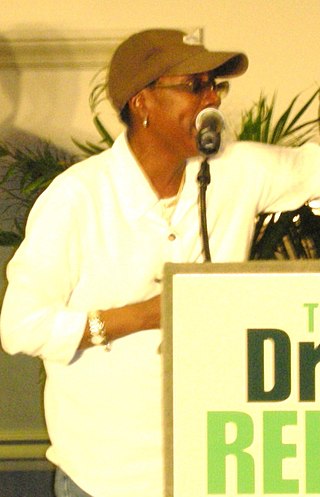
Angela Yvonne Davis is an American Marxist and feminist political activist, philosopher, academic, and author; she is a professor at the University of California, Santa Cruz. Davis was a longtime member of the Communist Party USA (CPUSA) and a founding member of the Committees of Correspondence for Democracy and Socialism (CCDS). She writes extensively on class, gender, race, and the U.S. prison system.

Solitary confinement is a form of imprisonment in which the inmate lives in a single cell with little or no meaningful contact with other people. A prison may enforce stricter measures to control contraband on a solitary prisoner and use additional security equipment in comparison to the general population. Solitary confinement is a punitive tool within the prison system to discipline or separate disruptive prison inmates who are security risks to other inmates, the prison staff, or the prison itself. However, solitary confinement is also used to protect inmates whose safety is threatened by other inmates by separating them from the general population.

Afeni Shakur Davis was an American political activist and member of the Black Panther Party. Shakur was the mother of rapper Tupac Shakur and the executor of his estate. She founded the Tupac Amaru Shakur Foundation and also served as the CEO of Amaru Entertainment, Inc., a record and film production company she founded.

The prison-industrial complex (PIC) is a term, coined after the "military-industrial complex" of the 1950s, used by scholars and activists to describe the relationship between a government and the various businesses that benefit from institutions of incarceration.

The Arkansas Department of Corrections (DOC), formerly the Arkansas Department of Correction, is the state law enforcement agency that oversees inmates and operates state prisons within the U.S. state of Arkansas. DOC consists of two divisions, the Arkansas Division of Corrections (ADC) and the Arkansas Division of Community Corrections (DCC), as well as the Arkansas Correctional School District. ADC is responsible for housing and rehabilitating people convicted of crimes by the courts of Arkansas. ADC maintains 20 prison facilities for inmates in 12 counties. DCC is responsible for adult parole and probation and offender reentry.
John Stoltenberg is an American author, activist, magazine editor, college lecturer, playwright, and theater reviewer who identifies his political perspective as radical feminist. For several years he has worked for DC Metro Theater Arts and is currently its executive editor. He has written three books, two collections of his essays and a novel. He was the life partner of Andrea Dworkin for 30 years and has lived with his husband, Joe Hamilton, for over 15 years.

Incarceration is a primary form of punishment and rehabilitation in the United States for the commission of felonies and other offenses. According to the latest available data at the World Prison Brief on May 7, 2023, the United States has the sixth highest incarceration rate in the world, at 531 people per 100,000; and the largest prison and jail population in the world at 1,767,200. In 2018, the United States had the highest incarceration rate in the world with 698 people incarcerated per 100,000, this includes the incarceration rate for adults or people tried as adults. This meant that one out of every 5 people imprisoned across the world in 2018 was incarcerated in the United States. Prison, parole, and probation operations generate an $81 billion annual cost to U.S. taxpayers, with an additional $63 billion for policing. Court costs, bail bond fees, and prison phone fees generate another $38 billion in individual costs annually.
Prison rape commonly refers to the rape of inmates in prison by other inmates or prison staff. In 2001, Human Rights Watch estimated that at least 4.3 million inmates had been raped while incarcerated in the United States. A United States Department of Justice report, Sexual Victimization in Prisons and Jails Reported by Inmates, states that "In 2011–12, an estimated 4.0% of state and federal prison inmates and 3.2% of jail inmates reported experiencing one or more incidents of sexual victimization by another inmate or facility staff in the past 12 months or since admission to the facility, if less than 12 months." However, advocates dispute the accuracy of the numbers, saying they seem to under-report the real numbers of sexual assaults in prison, especially among juveniles.
The women in prison film is a subgenre of exploitation film that began in the early 20th century and continues to the present day.

CoreCivic, formerly the Corrections Corporation of America (CCA), is a company that owns and manages private prisons and detention centers and operates others on a concession basis. Co-founded in 1983 in Nashville, Tennessee by Thomas W. Beasley, Robert Crants, and T. Don Hutto, it received investments from the Tennessee Valley Authority, Vanderbilt University, and Jack C. Massey, the founder of Hospital Corporation of America.
Arthur Kill Correctional Facility was a medium security correctional facility on Arthur Kill Road in Charleston, Staten Island, New York City. It operated from 1976 to 2011, run by what was then the New York State Department of Correctional Services. The prison had a capacity of 931 male inmates.

The Jefferson Market Prison was a prison in New York City at 10 Greenwich Avenue that opened in 1877, together with the adjacent Third Judicial District Courthouse. Frederick Clarke Withers designed these twin buildings in an ornate American Gothic style. The landmark courthouse survived Jefferson Market's 1927 demolition and today serves as a New York Public Library branch.

The Metropolitan Detention Center, Brooklyn is a United States federal administrative detention facility in the Sunset Park neighborhood of Brooklyn, New York City. It holds male and female prisoners of all security levels. It is operated by the Federal Bureau of Prisons, a division of the United States Department of Justice.

The Federal Detention Center (FDC Philadelphia) is a United States Federal prison in Center City, Philadelphia, Pennsylvania which holds male and female inmates prior to or during court proceedings, as well as inmates serving brief sentences. It is operated by the Federal Bureau of Prisons, a division of the United States Department of Justice.

Short Eyes is a 1974 drama written by playwright Miguel Piñero. The play premiered at the Theater of the Riverside Church, was then produced off-Broadway at the Joseph Papp Public Theater on February 28, 1974, and transferred after 54 performances to the Vivian Beaumont Theater on Broadway on May 23, 1974. Short Eyes, prison slang for a child molester, was written for a prisoners' writing workshop during Piñero's incarceration for armed robbery.
Pratibha Parmar is a British writer and filmmaker. She has made feminist documentaries such as Alice Walker: Beauty in Truth and My Name is Andrea about Andrea Dworkin.

A prison, also known as a jail, gaol, penitentiary, detention center, correction center, correctional facility, lock-up, hoosegow or remand center, is a facility in which inmates are confined against their will and usually denied a variety of freedoms under the authority of the state as punishment for various crimes. Prisons are most commonly used within a criminal justice system: people charged with crimes may be imprisoned until their trial; those pleading or being found guilty of crimes at trial may be sentenced to a specified period of imprisonment. In simplest terms, a prison can also be described as a building in which people are legally held as a punishment for a crime they have committed.

Lesbian, gay, bisexual, transgender and queer (LGBTQ) people face difficulties in prison such as increased vulnerability to sexual assault, other kinds of violence, and trouble accessing necessary medical care. While much of the available data on LGBTQ inmates comes from the United States, Amnesty International maintains records of known incidents internationally in which LGBTQ prisoners and those perceived to be lesbian, gay, bisexual or transgender have suffered torture, ill-treatment and violence at the hands of fellow inmates as well as prison officials.

Andrea Rita Dworkin was an American radical feminist writer and activist best known for her analysis of pornography. Her feminist writings, beginning in 1974, span 30 years. They are found in a dozen solo works: nine books of non-fiction, two novels, and a collection of short stories. Another three volumes were co-written or co-edited with US Constitutional law professor and feminist activist, Catharine A. MacKinnon.
Hugh Ryan is a historian and non-fiction writer focusing on the LGBT history of New York City. He wrote The Women's House of Detention: A Queer History of a Forgotten Prison and When Brooklyn Was Queer.














